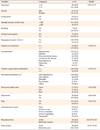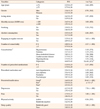Abstract
Purpose
Fatigue is common in older adults and may decrease the quality of life. The purpose of this study was to investigate the level and characteristics of fatigue of older adults, and identify the factors associated with fatigue.
Methods
This study used a secondary data analysis (n=200). Data collection was conducted from July to September 2015. Fatigue Severity Scale, Geriatric Depression Scale Short Form Korea Version, Korean Version of Physical Activity Scale for Elderly, and Verran & Synder-Halpern Sleep Scale were used.
Results
We used the data from 200 older adults in a local senior welfare center. Their average age was 74.5 years. We found that 35.5% of them had fatigue (≥4). The reported factors alleviating fatigue were taking rest, warm bath, and sleeping. Engaging in light sports was also reported to alleviate fatigue. The level of fatigue was higher in subjects with older age (p=.009), lower income (p=.003), higher number of diseases (p<.001), more medications (p<.001), and lower perceived health status (p<.001). In multiple linear regression analysis, the factors predicting fatigue were older age (p<.001), depression (p<.001), pain (p=.001), irregular exercise (p=.013), and lower perceived health status (p<.001). The explanatory power of the model was 47.5%.
Figures and Tables
ACKNOWLEDGEMENT
This article is a condensed form of the first author's master's thesis from Seoul National University.
References
1. Nijrolder I, Leone SS, van der Horst HE. Explaining fatigue: an examination of patient causal attributions and their (in)congruence with family doctors' initial causal attributions. Eur J Gen Pract. 2015; 21(3):164–169. DOI: 10.3109/13814788.2015.1055556.

2. Yu DSF, Lee DTF, Man NW. Fatigue among older people: a review of the research literature. Int J Nurs Stud. 2010; 47(2):216–228. DOI: 10.1016/j.ijnurstu.2009.05.009.

3. Meng H, Friedberg F, Castora-Binkley M. Cost-effectiveness of chronic fatigue self-management versus usual care: a pilot randomized controlled trial. BMC Fam Pract. 2014; 15(184):1–9. DOI: 10.1186/s12875-014-0184-7.

4. Choi YH. A study on depression, sleep and fatigue in the younger and older elders. J Korean Acad Community Health Nurs. 2007; 18(2):223–231.
5. Jang IS, Park SM. Comparison of depression according to health-related characteristics among the elderly who visited a senior center. J Korean Data Anal Soc. 2014; 16(4):2205–2216.
6. Cha BK, Park CS. A comparison of pain, pain interference and fatigue according to the level of physical activity in the elderly with chronic pain. J Korean Acad Community Health Nurs. 2011; 22(2):162–172. DOI: 10.12799/jkachn.2011.22.2.162.

7. Kim GM, Lee YM, Chang SO. Factors influencing fatigue in elderly people with chronic pain. J Korean Acad Psychiatr Ment Health Nurs. 2011; 20(1):61–70.

8. Park MS. Fatigue and related factors in elderly people living at home. J Korean Gerontol Nurs. 2009; 11(2):173–183.
9. Soyuer F, Şenol V. Fatigue and physical activity levels of 65 and over older people living in rest home. Int J Gerontol. 2011; 5(1):13–16. DOI: 10.12934/jkpmhn.2011.20.1.61.

10. Ministry for Health and Welfare. The physical activity guide for Koreans [Internet]. Seoul: Ministry of Health and Welfare;2013. cited 2014 September 5. Available from: http://www.mohw.go.kr/react/jb/sjb030301ls.jsp?PAR_MENU_ID=03&MENU_ID=032901.
11. Krupp LB, LaRocca NG, Muir-Nash J, Steinberg AD. The Fatigue severity scale: application to patients with multiple sclerosis and systemic lupus erythematosus. Arch Neurol. 1989; 46(10):1121–1123. DOI: 10.1001/archneur.1989.00520460115022.
12. Chung KI. Clinical usefulness of fatigue severity scale for patients with fatigue, and anxiety or depression. Korean J Psychosom Med. 2001; 9(2):164–173.
13. Yesavage JA, Sheikh JI. 9/Geriatric Depression Scale (GDS) recent evidence of a shorter version. Clin Gerontol. 1986; 5(1-2):165–173. DOI: 10.1300/j018v05n01_09.
14. Kee BS. A preliminary study for the standardization of geriatric depression scale short form-Korea version. J Korean Neuropsychiatr Assoc. 1996; 35(2):298–307.
15. Eggermont LHP, Leveille SG, Shi L, Kiely DK, Shmerling RH, Jones RN, et al. Pain characteristics associated with the onset of disability in older adults: the maintenance of balance, independent living, intellect, and zest in the elderly Boston study. J Am Geriatr Soc. 2014; 62(6):1007–1016. DOI: 10.1111/jgs.12848.

16. Washburn RA, Smith KW, Jette AM, Janney CA. The physical activity scale for the elderly (PASE): development and evaluation. J Clin Epidemiol. 1993; 46(2):153–162. DOI: 10.1016/0895-4356(93)90053-4.

17. Choe MA, Kim J, Jeon M, Chae YR. Evaluation of the Korean version of physical activity scale for the elderly (K-PASE). Korean J Women Health Nurs. 2010; 16(1):47–59. DOI: 10.4069/kjwhn.2010.16.1.47.

18. Snyder-Halpern R, Verran JA. Instrumentation to describe subjective sleep characteristics in healthy subjects. Res Nurs Health. 1987; 10(3):155–163. DOI: 10.1002/nur.4770100307.

19. Kim KH. Quality of sleep and sleep disturbance factors of coronary artery disease patients in CCU [master's thesis]. Seoul: Ewha Womans University;2001.
20. Yun SH. The effects of aroma inhalation on sleep and fatigue in night shift nurses [master's thesis]. Seoul: Yonsei University;2008.
21. Suh M, Choi-Kwon S. Structural equation modeling on quality of life in stroke survivors. J Korean Acad Nurs. 2010; 40(4):533–541. DOI: 10.4040/jkan.2010.40.4.533.

22. Jing MJ, Wang JJ, Lin WQ, Lei YX, Wang PX. A communitybased cross-sectional study of fatigue in middle-aged and elderly women. J Psychosom Res. 2015; 79(4):288–294. DOI: 10.1016/j.jpsychores.2015.05.009.

23. Lee SW, Bae JY, Yoon SH, An KE. A study on the development of the Korean depression scale. J Korean Acad Psychiatr Ment Health Nurs. 2003; 12(4):433–443.
24. Cho CE, Jeong JH, Chang SM. Prevalence of major depressive disorder: association with risk factors and mini-mental state examination. J Korean Soc Biol Ther Psychiatry. 2015; 21(1):27–35.
25. Choi YH. Is subjective health reliable as a proxy variable for true health? a comparison of self-rated health and self-assessed change in health among middle-aged and older South Koreans. Health Soc Welf Rev. 2016; 36(4):431–459. DOI: 10.15709/hswr.2016.36.4.431.
26. Avlund K. Fatigue in older adults: an early indicator of the aging process. Aging Clin Exp Res. 2010; 22(2):100–115. DOI: 10.1007/bf03324782.

27. Lee EO, Kim JI, Davis AHT, Kim I. Effects of regular exercise on pain, fatigue, and disability in patients with rheumatoid arthritis. Fam Community Health. 2006; 29(4):320–327. DOI: 10.1097/00003727-200610000-00010.

28. Egerton T, Chastin SFM, Stensvold D, Helbostad JL. Fatigue may contribute to reduced physical activity among older people: an observational study. J Gerontol A Biol Sci Med Sci. 2015; 71(5):670–676. DOI: 10.1093/gerona/glv150.

29. Jeon BM, Choi-Kwon S. Factors Influencing Sleep Disturbances among Older Adults Living within a Community. Korean J Adult Nurs. 2017; 29(3):235–245. DOI: 10.7475/kjan.2017.29.3.235.





 PDF
PDF ePub
ePub Citation
Citation Print
Print








 XML Download
XML Download